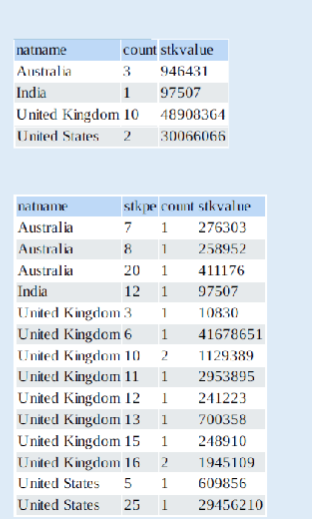Chapter 4: One-to-Many Relstionship
Link multiple entities together Relationship between one instance of an entity to many instances of another entity
Why we need multiple tables?
redundant data and redundant operation
Potential Problems
insert: need to duplicate exchange rate delete: delete the compony, we also remove the india update
How to solve this problem
Split: the redundant info Link: the two tables» Foreign Key is same as the PK of another table
CONSTRAINT fk_has_nation FOREIGN KEY(natcode) REFERENCE nation(natcode);
1: m Relationship E-R(Entity- Relationship) Diagrams
a diagram is not a table. It’s a story with relations. the difference between the 1:1 and 1:m
- label(relationship descriptor)
FK and PK
are both a column or collection of columns
Could PK use multiple attributes?
Yes PRIMARY KEY(stkcode, stkfirm)
Query on 1:m(How to use these)
Join
step1: combine all the rows SELECT * FROM(就是选择了所有的rows) Table1 , Table2; step2: restrict the values of some columns WHERE Table1.ID +100 =Table2.ID;
SELECT * FROM stock JOIN nation ON stock.natcode = nation.natcode; not only equal, but other operation (显式连接)
这个Query是错的,为什么? SELECT natname, natcode, stkfirm, stkprice, stkqty, exchrate, stkpricestkqtyexchrate AS stkvalue
FROM stock, nation
WHERE stock.natcode = nation.natcode (隐式连接) 因为: 这个在两个表里面都有,所以要进一步指定这个是属于哪个的
Group by
SELECT natcode, COUNT(natcode) FROM stock WHERE stkprice >10 GROUP BY natcode;
Group by可以用于两个columns, 把两个columns都当做new table的PK来进行分类

Having
SELECT natname, SUM(stkpricestkqtyexchrate) AS stkvalue
FROM stock, nation WHERE stock.natcode = nation.natcode
GROUP BY natname
HAVING COUNT( * ) > 2
View of Database
for different people give them different tables Beneifits: restrict access to parts of a table save memory space simplify query writing
就是创建了一个新表 CREATE VIEW stkvalue (nation, firm, price, qty, exchrate, value)
AS
SELECT natname, stkfirm, stkprice, stkqty, exchrate, stkpricestkqtyexchrate
FROM stock, nation
WHERE stock.natcode = nation.natcode; 下一次我们就可以直接用SELECT * FROM stkvalue
Subqueries
就是有点像普通就执行一次,搞一整个表,correlated就是一行一行的搞 ![[9a9f6c7ea251685632bde7d3ca4b494.png]]
Normal Subquery
Use brackets to specify subquery
SELECT shrfirm, shrpe FROM share
WHERE shrpe > (SELECT AVG(shrpe) FROM share);
Correlated Subquery
that country : we don’t know the compony belong to which coutry
SELECT natname, stkfirm, stkqty FROM stock, nation
WHERE stock.natcode = nation.natcode
AND stkqty >
(SELECT avg(stkqty) FROM stock
WHERE stock.natcode = nation.natcode)
文档信息
- 本文作者:Xinyi He
- 本文链接:https://buliangzhang24.github.io/2024/04/07/SQL-Lecture-2/
- 版权声明:自由转载-非商用-非衍生-保持署名(创意共享3.0许可证)
